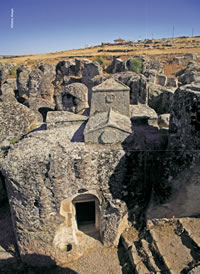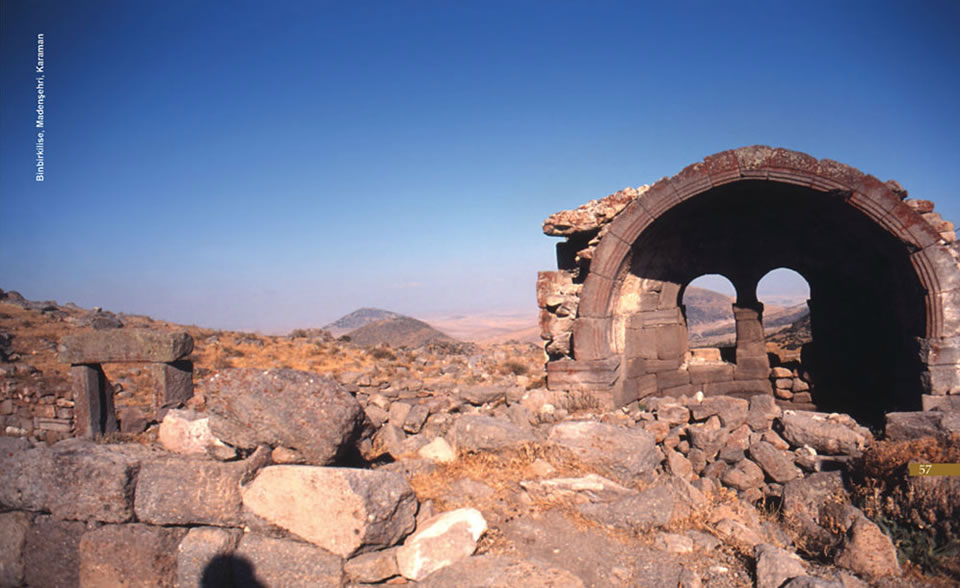St Paul in Hatunsaray (Lystra) and Derbe
 Coming to Hatunsaray (Lystra) by a plan of their own making to escape being assaulted, St. Paul performed a miracle by endowing a man who had been crippled from birth and who had never walked, with the ability to walk. The people of Lystra were greatly impressed by the miracle and attributed to SS. Paul and Barnabas the names of pagan gods because they assumed that they were these gods. They wanted to organise ceremonies at the city gates and sacrifice animals in their honour. I tearing this SS. Paul and Barnabas tore their clothes and went among the people saying "we are people just Iike you and we have brought you the Good News. Leave empty gestures like this and turn to the one God that created everything" and thus prevented the sacrifice. However elements against Christianity from outside the city took the people of Lystra to their side and had St. Paul stoned. Despite the heavy injuries he incurred he did not stop to recuperate but went together with St. Barnabas to Derbe where he succeeded in converting many people to Christianity with his words. This city was the final stop of the first journey. From here they started to return by the same route that they had come. En route they again spoke to those that they had earlier inducted into the faith and gave the believers courage. Derbe and Lystra are places that St. Paul also
visited on his second journey; coming here he wanted to see how those that he converted earlier were faring. In Lystra he found one of his greatest , supporters, a man called Timothy whom he kept close to him and together with whom he continued journeys.
Coming to Hatunsaray (Lystra) by a plan of their own making to escape being assaulted, St. Paul performed a miracle by endowing a man who had been crippled from birth and who had never walked, with the ability to walk. The people of Lystra were greatly impressed by the miracle and attributed to SS. Paul and Barnabas the names of pagan gods because they assumed that they were these gods. They wanted to organise ceremonies at the city gates and sacrifice animals in their honour. I tearing this SS. Paul and Barnabas tore their clothes and went among the people saying "we are people just Iike you and we have brought you the Good News. Leave empty gestures like this and turn to the one God that created everything" and thus prevented the sacrifice. However elements against Christianity from outside the city took the people of Lystra to their side and had St. Paul stoned. Despite the heavy injuries he incurred he did not stop to recuperate but went together with St. Barnabas to Derbe where he succeeded in converting many people to Christianity with his words. This city was the final stop of the first journey. From here they started to return by the same route that they had come. En route they again spoke to those that they had earlier inducted into the faith and gave the believers courage. Derbe and Lystra are places that St. Paul also
visited on his second journey; coming here he wanted to see how those that he converted earlier were faring. In Lystra he found one of his greatest , supporters, a man called Timothy whom he kept close to him and together with whom he continued journeys.
There is not much in Lystra nowadays, except for amound, in terms of monuments that have survived from the years in which St. Paul visited that could help bring it to life for us. The most important monuments with respect to Christianity are in the village of Gokyurt (Kilistra) 12 km to the west of Lystra. It is thought that the settlement was founded by the first Christians from Lystra who Ieft on account of persecution.
 Research has shown that most of the remains date from a slightly later period, generally the 8th ant] 9th GA.D. The remains include cisterns of cut rock, towers, churches which are reminiscent of those found in Capadoccia, isolation cells and a monastery; it is more than probable that St. Paul used the stone paved road that led from Lystra to Kilistra and that continued inside the city called the King's Road. Even today the place in which the Sümbül Church is located is referred to as "Paulönü Mevkii" (lit. Paul's Locale). Sandikkaya is a rare example of a church of which interior and exterior parts were carved out of rock with a roof form, and it is amongst the places that you should definitely see along with the stone cut chapels, sloping houses, and Sumbul Church in the ancient city.
Mostly dating from between the 4th and the 9th centuries hundreds of churches in Derbe and its environs demonstrate how quickly the teachings of Jesus Christ were spread through the efforts of St. Paul. The region is nowadays referred to as "Binbirkilise" (lit. "A thousand and one churches")
Research has shown that most of the remains date from a slightly later period, generally the 8th ant] 9th GA.D. The remains include cisterns of cut rock, towers, churches which are reminiscent of those found in Capadoccia, isolation cells and a monastery; it is more than probable that St. Paul used the stone paved road that led from Lystra to Kilistra and that continued inside the city called the King's Road. Even today the place in which the Sümbül Church is located is referred to as "Paulönü Mevkii" (lit. Paul's Locale). Sandikkaya is a rare example of a church of which interior and exterior parts were carved out of rock with a roof form, and it is amongst the places that you should definitely see along with the stone cut chapels, sloping houses, and Sumbul Church in the ancient city.
Mostly dating from between the 4th and the 9th centuries hundreds of churches in Derbe and its environs demonstrate how quickly the teachings of Jesus Christ were spread through the efforts of St. Paul. The region is nowadays referred to as "Binbirkilise" (lit. "A thousand and one churches")
Pilgrimage
RELIGIOUS
- The First Journey of St.Paul
(46-48 A.D.) - The Second Journey of St.Paul
(49-52 A.D.) - The Third Journey of St.Paul
(53-57 A.D.) - The Fourth Journey of St. Paul
(58-64 A.D.)s - St Paul in Mersin
Mut, Tarsus, Silifke - St Paul in Antakya
Antioche, Samandag - St Paul in Perge
- St Paul in Yalvaç
- St Paul in Konya
- St Paul in Hatunsaray And Derbe
- St Paul in Ephesus
- St Paul in Canakkale
- St Paul in Demre
- Cappadocia
- Turkish Coast
- Did you know
